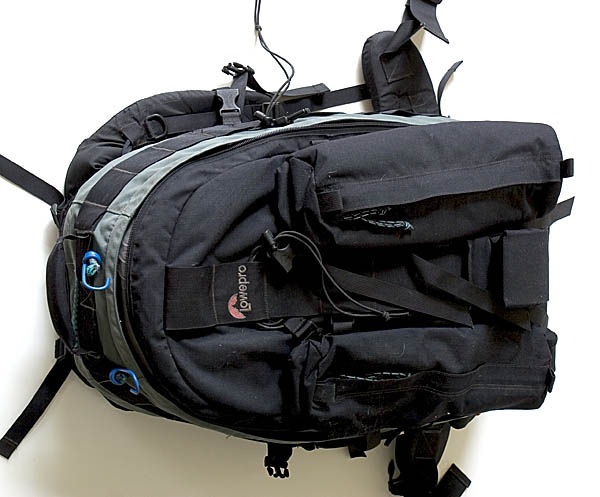
The exterior of my Super-trekker.
by Q.-Tuan Luong for largeformatphotography.info
This article describes the gear I carry in my general-purpose large-format bag, the reasons why I chose that gear, and how it is organized inside the bag. All the items described, with the exception of 35mm equipment that is sometimes taken out separately, are left permanently in the bag. This makes it possible for me to always know where eachitem is. It also prevents me from forgetting to pack something.
While inadequate for backpacking or even some long hikes (another article will detail my camera bags for those situations), for working near the car and moderate hikes (as long as the Subway in Zion), the Lowepro Super-trekker is my choice because it provides quick access, good organization, and reasonable carrying ability. In addition, it offers sufficient protection for shipping by air, and a rain cover that makes it possible to leave it or cache it outside even in rainy weather. I have checked in the bag numerous times with minimal damage to the gear (limited to the cable releases). I have also left it several times out in the elements, for example when working in Denali together with a camping backpack (I want to reassure you that I wasn't carrying both simultaneously, but a discussion of Denali logistics would be alone worth another article).

When I don't carry the tripod by hand, it is secured to the bag in central position by the bungee cord with blue hooks. The default bungee cords, which are not as strong, are used to carry additional clothing when needed. With my cheap bungee cord positioned that way, a Gitzo 1325 can easily be carried on the bag. Carrying such a large tripod on the side would make the bag too unbalanced. The two external pockets are used to carry non-photographic items including food, water, and accessories such as umbrella, hat, gloves, knife, headlamp, map, and GPS unit.
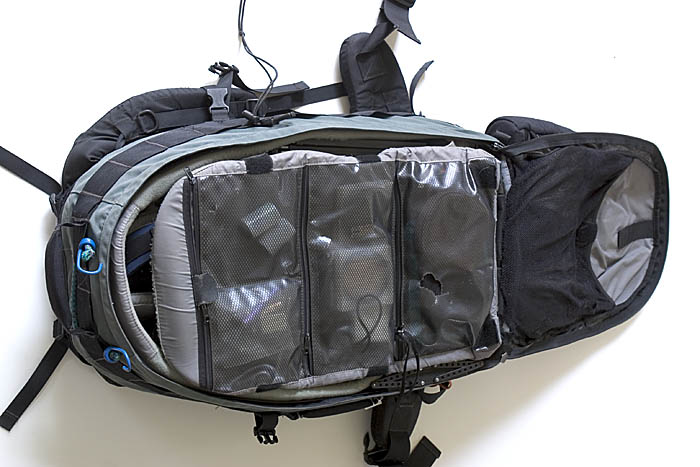
On the inside of the cover flap, there is a mesh pocket which normally contains just the focussing cloth. I use the Darkroom Innovations excellent cloth (compact, light, wind-proof, water-resistant, and above all, ensures good darkness, thanks to its tube design and elasticised opening). Occasionally, the same mesh pocket would be used to carry additional film in a boxes and a small changing bag, or a few more 5x7 holders.
On top of the bag's main compartment, there is a removable foam panel with four clear zippered pockets that contains any accessories. For shipping, I simply reverse this panel to protect the contents inside the pockets, which would then be facing inside. One of the small pockets is dedicated to 35mm accessories (film, spare battery, double spirit level). The three other zippered pockets are detailed below.
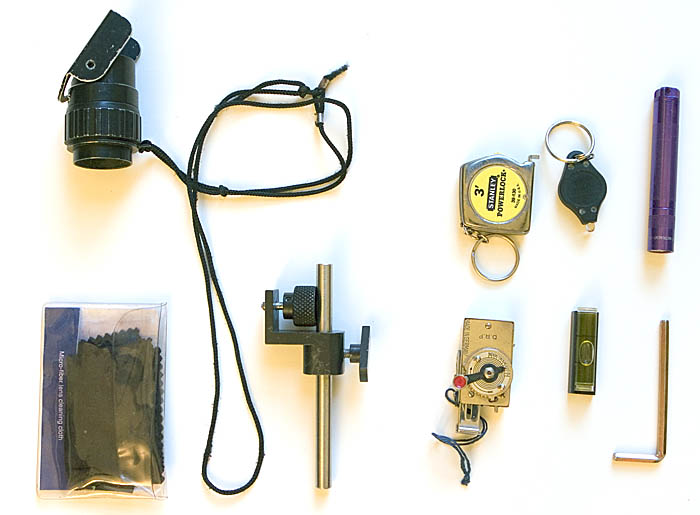
This pocket contains the two most indispensable accessories:
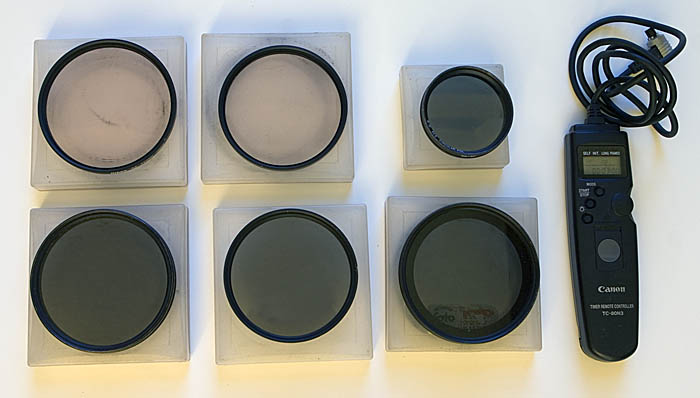
This pocket contains round filters for dual use 35mm/LF: they consist of Heliopan warm-tone Kaeseman Circular polarizers in 72mm and 77mm, Nikon 81B warming filters in 72mm and 77mm. There is also a Heliopan wide-angle linear polarizer (front element is larger than than filter thread to preven vignetting) in 67mm, as well as Nikon a 52mm polarizer which are both used only for LF. All round filters are in B&W soft plastic boxes. The Canon remote controler is used not only with the 35mm camera (cable release, extended self-timer, long exposures), but also its timing function is used for long LF exposures.
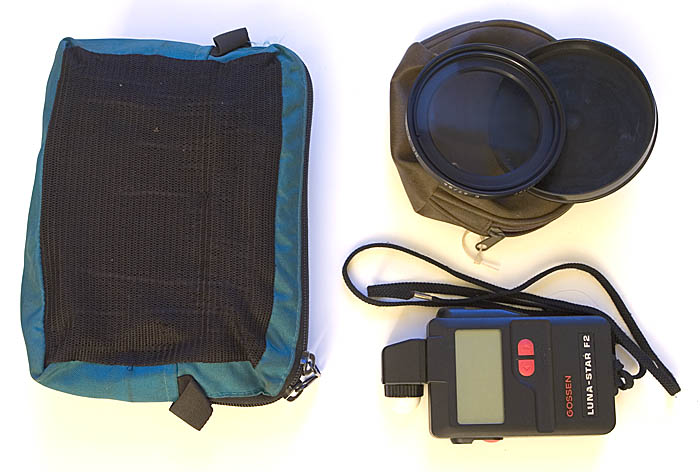
This pocket contains a small Outdoor Research mesh bag which holds the rectangular filter system, a Heliopan 0.45 center filter in 67mm to compensate for light fall-off in some shots with the Schneider 110 XL and the Nikkor 90/8 (this is carried in a push-on lens cap inside a soft pouch), and a Lunar-Star F2 incident/flash meter (rarely used, as for most landscape situations I prefer to meter with the 35mm camera).
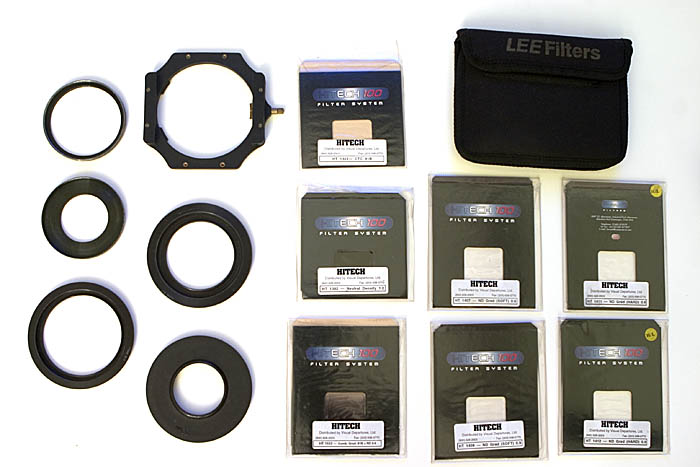
The filter bag contains a Lee holder, wide-angle rings in 67mm and 77mm, a regular ring in 52mm, three step-up rings to use the Lee holders on other filter diameters, and a pouch containing resin Hitech filters. Those include graduated neutral density 4x5 (GND), with both soft and hard transistions in 2 f-stops and 3 f-stops, combination GND and warming filter, and two 4x4 filters: warming filter (81B), and neutral density filter (used to obtain longer exposures time to smooth moving water). The Lee system, with its wide-angle rings, works without vignetting even for wide-angle lenses. The Hitech filters are considered as good as the Lee filters (some think they are produced by the same factory), but their cost is lower.
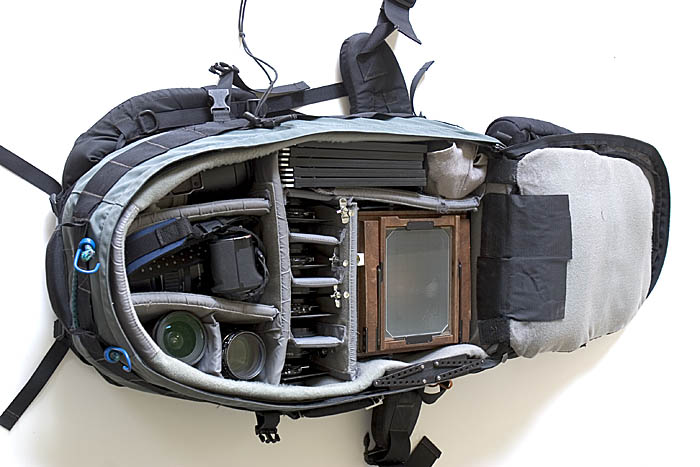
The inside of the bag contains the cameras, lenses, film holders. I normally carry five or six 5x7 holders at a time. Note that I have added two large Velcro pieces to hold more firmly the removable panel, since the stock Velcro attachements are too small and would often let the removable panel come loose. In 35mm, in general I carry one Canon EOS body with a mid-range zoom, one telephoto zoom lens, and one wide-angle zoom lens. The 35mm body is used not only independently, but also as a viewfinder and a meter for the LF camera. The 35mmm equipment is placed at the top of the bag, so I can access it without need to opening entirely the bag or lay it flat. There is some space between the external dividers and the exterior shell of the bag. This space is used to carry the accessories listed in the next image.

Those accessories include the Canham compendium shade (always useful to improve image contrast by reducing flare and cuting down the image circle, also protects the lens while working in the rain), a small grey card, four step-up rings that provide additional redundancy, should a filter be misplaced or damaged, and a folded piece of foil that can be attached to the removable panel of the Super-trekker to transform it into a reflector. This can be useful for adding a bit of fill light for macros shots or a close foreground.

I own 7 large format lenses, which cover focals from 90mm (equivalent of a 18in 35mm) to 720 (equivalent of a 135 in 35mm). All of them are good performers, relatively recent and multicoated, which is useful since my work is color. You will remark that I have a mix of each of the four major brands. Since I do not do work that require critical color matching (such as product illustration), this has not posed me any problem. All of my lenses are mounted on Technika lens boards, which is the de-facto standard for field cameras, smaller than the Toyo boards (I also own a Tech IV that I almost never use these days). I prefer the original Technika boards. Despite lensboards being very simple objects, there is actually a difference in quality. The four most frequently used lenses have a cable release permanently attached to them to speed-up set-up. It is necessary to remove the cable release before shipping, since in my experience, the cable releases are the only piece of equipment to have been damaged in transit (they break near the socket). The front element is protected by a UV filter that I remove if the weather conditions are fine. Those lenses, pictured on the first row (in the four compartments above the camera) are, left to right:

My camera of choice is the Canham wood field in the 5x7 format, with a couple of modifications. I replaced the standard bellows with the more flexible MQC bellows, as well as the rather coarse and dim focussing screen with a Boss screen. I installed a metric scale on a focussing rail, and two additional spirit levels, one on the back, and another one on the bed. For more details, see my review of the 5x7 KBC. A Really Right Stuff plate is permanently attached under the bed of the camera for tripod mounting. I carry the wide-angle bellows underneath the camera (under a large grey card that serves as divider), but since installing the MQC bellows, I have had rarely the need for it.